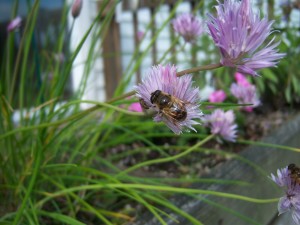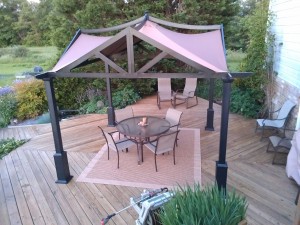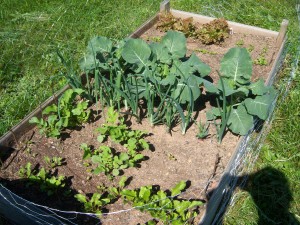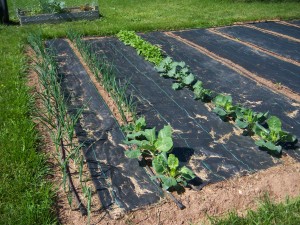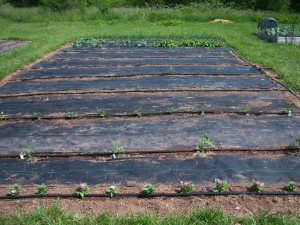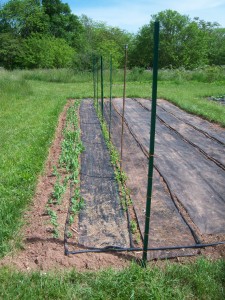
What’s flowering in June
0When we moved to our property – before we were calling it the farm – we were impressed with the landscaping. It needed some TLC, but throughout our first year, it became clear that there were lots of flowering plants with almost continuous blooming from early spring through fall. I always look forward to the progression from crocuses to dafodils to tulips to irises to day lillies and so on. We have added a few things and Mother Nature throws in her splash of color as well.
Last week I decided to walk around and take a few pictures of some of the late June color. Here is what I found.

How are the bees?
0I inspected the bees a few days ago and found them in pretty good shape, but not ‘developing’ as quickly as I had hoped. The two old hives still have queen excluders on with signs of a little comb being built. Hive A is still brimming with bees and I believe that they have plenty of honey stored in the brood area. Maybe I will be able to extract some of that honey later this summer. Hive B is not as busy at the entrance nor does it seem as full inside, but is a good strong hive for this time of year. Both A and B have new queens this year.
Hive C still has the burr comb in the feeder, but without the queen excluder on it is now (I think) being filled back up with honey. I don’t think there is any brood in it, but am not sure. A few weeks ago I added a medium brood box on top of the deep and under the feeder and there is still plenty of room in that box.
Hive D is the first swarm hive which should have one of the original queens from either A or B, but I found the queen and she is not marked (both queens from A and B last year had white marks for 2011). So I am a bit stumped. Maybe that queen was superseded either before or after it swarmed. Maybe the white dots can wear off. I’m not really sure, but in any case hive D is busting out with bees. I didn’t look in the bottom brood box, so I don’t know if there were any queen cells, but I did get a queen excluder and a new medium box on top. I hope I got the new box on in time. Most of the pictures are from hive D.
Hive E is a swarm from hive C (2012 Georgian bees) and although I believe hive C swarmed twice, hive E was from the first swarm. I haven’t found the queen yet, but it should also be marked. It had a white dot when I got it in March even though it should have been yellow for 2012.

June bees and flowers
0I am always interested in what my honeybees are finding to forage on the property. They can fly three or so miles to find food, but the more I can offer them in my yard, the better. I haven’t planted a field of wildflowers yet, so the bees only have access to the native wildflowers and weeds. This June there has been a lot of clover in the grass and tons of Crown Vetch. I have seen the bees on both, but not much, so they must still be finding sources elsewhere.

Broccoli
0The garden looks pretty good at this time of year. Some things are already being harvested (radishes, lettuce, spinach, and broccoli), and the rest of the plants look good. The weeds aren’t too bad yet and the bugs are just getting their bearings. This week’s exciting news is that we got some broccoli. We have never grown it before, but it was easy, fast and in the end, delicious. It looks like we will get one nice head of broccoli for plant (we have five), but we think there may be a small secondary head or two that form just below the cut. Here’s to hoping.
Today I also planted another half row of bush beans (Derby) (about 2.5 weeks from the first planting). I hope to do this two more times at two to three week intervals.

May bee inspection
0I needed to move the last three hives out about two feet to have more room to move around behind the boxes. The set up was fine when there were only two hives, but when I added the three new ones this spring, I was just too cramped. It’s a daunting task, really, to move three hives forward two feed in the middle of the day. In order to do it I needed to temporarily move them to the side in order to move cinder blocks and 4 x 4 supports. When the hives are moved four feet to the side or back, the returning foragers can’t find the hive and the cloud of bees just gets thicker and thicker. So time is of the essence. I got them moved and the bees were pretty tolerant considering the disruption.
After moving hives 3, 4, and 5, I really wanted to look inside hives 1 and 5 because there was so little activity at the hive entrance that I was worried that they might be dead. They weren’t. Hive 1 (formerly Boston, and with five now I decided numbers were just going to be easier) had nothing in the honey super – no surprise there – but there certainly were bees in both deep boxes. Ok, so there are bees, but is there a laying queen. I have not seen a queen or any eggs since the hive swarmed seven weeks ago. In fact, I really hadn’t looked. I was going on faith that the hive had a new queen. The good news is that there was brood and a real live queen whom I saw after looking casually at just a few frames. You can see her in a couple of the close-ups above. That was just dumb luck. So I don’t really know why that hive has so little foraging going on, but it might have to do with the swarming and cycle of brood. At this point, I rather expect to see a large increase in the population very soon, and the young bees will soon become foragers. Time will tell.
Hive 2 has been super busy at the entrance and has more bees inside, but I didn’t inspect today.
Hive 3 was the new Georgia bee hive that I think swarmed twice. It has the comb in the feeder box above a queen excluder. The feeder box was acting like a honey super. I should have realized this, but there were lots of drones trapped in that box because they couldn’t get down through the excluder and they probably ate all the honey that had been stored there. It looked mostly empty. There is a screened cover over the feeder box, but it might not have an escape. I removed the queen excluder, mostly to let the drones out. I might just clean out the comb, the next time I inspect.
Hive 4 had a feeder box with nothing in it except a few larvae that might have been Small Hive Beetles. There was one large white larva that I removed and killed. Not sure what it was. It was 10 times the size of the small larvae.
Hive 5 had bees as it turned out, but, again, they were very quiet at the entrance. It was swarm 3, so the first of the Georgia swarms. It should, therefore, have a marked queen. As I recall, these are marked white even thought Jason Hough said they were 2012 queens which should be yellow, I think. I guess I just will never know for sure. But I should be able to find that queen and get a picture of her one of these days.
I still haven’t done anything to measure varroa, so that is another project that needs to happen soon.

Hoverflies
0The herbs on our deck are blooming including the pretty violet flowers atop the slender chive stalks. I was excited to see several of my honeybees enjoying the flowers. When I looked a little closer, they appeared to be drones (male honeybees) with their large bodies and large black eyes. Then upon even closer inspection, I decided that they weren’t bees at all. I think they were hoverflies. I found a nice website with pictures of lots of different types of hoverflies at: http://www.microscopy-uk.org.uk/mag/artmay07/cd-hoverflies.html. The ones I saw seemed a little different than all the pictures, but there is a lot of variety in this family. One of the major differences between bees and flies is that bees have two sets of wings, whereas flies have only one.

Gazebo
0We had been thinking of adding some type of covered area to the deck for some time and we both liked this gazebo that we found at Lowe’s We get some pretty strong winds out here and we liked the more open design of this one that allows the winds to blow through more. We didn’t want a more solid wall structure that the wind might just blow over or lift up and destroy. This one has a light canvas top that is easily removed in a few minutes time if it looks like we are in for a really nasty storm. We have been eating more meals outside and it gives us great protection from the mid-day sun. It’s also nice and cozy to sit out there at night with a few lighted candles.

Happy 14th Birthday, Ellie!
1After dealing with the growth on Ellie’s face for 5-6 weeks, we decided to risk surgery and have it removed. It just became too difficult for us to manage as the growth would bleed profusely at the slightest bump and easily became infected. Poor Ellie was just miserable, between wearing the e-collar all the time and us trying to keep the growth cleaned, it felt like we were torturing her. We took her into the clinic early the day of her surgery in order to complete some testing first. We had decided that if her blood work looked good, we were going to go for the surgery. We understood the risks associated with anesthesia were higher in her case as she has a heart murmur and some arrythmia had been noted. We felt that if she did not survive the surgery, at least she would not be awake and wouldn’t suffer any pain. She was starting to get so upset each time we had to work on cleaning her up and her heart rate increased to the point that I was afraid she might suffer a heart attack and then she would suffer a painful death. Her blood work came back in all normal ranges so the surgery was a go.
Dr. Bramson performed the surgery and Dr. Keane also came in to help monitor the anesthesia. Nancy and I were both in surgery to assist the doctors, so Ellie had a lot of people working to make sure she came through in good shape. She was just lightly under anesthesia and for as short as time as possible. She was pretty out of things for the rest of the day and through the night, which was to be expected. By the second day she felt like eating a bit and was on the road to recovery.
She developed a lot of edema below the surgical site and her poor face was so swollen for several days but now she is looking really good and it is such a relief for her as well as us to be rid of that growth. Oh, and May 18 was Ellie’s birthday – 14 years old! I’m so glad she could celebrate the day without the e- collar! Happy Birthday, sweet girl!
Swarm number 5
0They just keep coming … and going. I thought I had seen my last swarm, but number five left my third hive (Georgia bees installed in March) and landed on the same magic bee bush as the previous four swarms. I had just received some new woodenware, so I quickly assembled four boxes and then painted them to get them ready for the swarm. It was about three or four hours later when I went out to capture the swarm in a nuc box, but they had already departed for a new home.
I am pretty sure that the swarm had just left the hive when I saw it this morning. There were lots of bees in the air, lots around hive 3, and they seemed to be collecting on the bush. In about 15 minutes, there were noticeably fewer bees in the air and around the hive and bush. It certainly looked like they had just swarmed and settled down. However, a half hour later, I saw a waggle dance on one section of the swarm. I didn’t look on other parts of the swarm. If they had just swarmed, how could a scout be doing a waggle dance already? I don’t know. I didn’t really want another hive, but I surely didn’t want to lose another half of my Georgia bees.
The previous swarm from that hive was 19 days ago. At best the new queen has only been laying for a few days or maybe a week. Now there will be another approximately 14 days until another new queen will start laying eggs. So in two weeks, that hive will have gone about a month without new brood (possibly a few days worth of eggs in the middle). The rest of the bees will be pretty old. It seems like I should expect a population crash and slow rebuild.
This is the hive that has the burr comb in the feeding box. I looked at it today and I saw a little of it capped with honey, but lots of it looking mostly empty. I was kinda hoping that it was all going to be capped honey by now. I recently installed a new medium brood box between the deep brood box and the feeding box, hoping to prevent swarming and giving them plenty of expansion space. Apparently, I was too late.
I also moved the first two hives forward about two feet to give myself more room to work on the hives from behind. Again, I had the chance to see what was going on in the supers I put on a couple of months ago. There was still no nectar being stored there. Below the super there are two deep brood boxes. I removed the super and then the top brood box. It must have weighed 50 pounds. So no honey in the super, but a brood box with lots of honey. I didn’t look at the frames today. The second hive was similar but not as heavy – perhaps only 30 pounds in the top brood box. Both lower brood boxes were lighter than the upper boxes, but, again, I didn’t inspect further. That will be another day soon.
I need to move the three smaller hives forward, too. I might be able to just lift them intact and set them on the new stand. They are not nearly as heavy as the first two hives.

Filling out the garden
0This past weekend we planted most of the garden space. We have been harvesting radishes almost daily, but the garden has not produced anything else yet. The spinach and lettuce didn’t do very well this year. We didn’t plant much and something ate the tender little tops once or twice which didn’t help. Three of the six lettuce plants that I bought at the store died suddenly. They were chewed off or rotted right at ground level. The beets didn’t germinate very well, but the few that did have finally started to grow a little bit. We might end up with 10 beets. There were also two small eggplant plants that had the tops eaten down. The first plant before I put up a two foot fence and the second one after I put up the fence. Something seemed to have climbed over the fence, pulling it down somewhat in the process. I reinforced it and I am hoping that will be enough. I am also hoping that the little plants come back. I bought one replacement today. This was all in the small raised bed garden.
The main garden plot was filled out with a bunch of tomato plants, peppers, edamame (soy beans), and lima beans. The onions, broccoli and brussels sprouts look pretty good, but the onions are sending up flower stalks. We snapped them off this year although Joni thinks that it might not help. Maybe they are already slowing down bulb development. We’ll see. This is the first year trying broccoli and brussels sprouts so we shall see how they do. I am expecting a great big green plant with some small barely harvestable parts, but maybe I will be surprised. Not setting my sights too high for these.
We spaced out the tomato plants a little wider this year and put some rows of peppers in between. We are really looking forward to harvesting and canning lots of tomatoes, tomato sauce and salsa. We planted six Roma plants, a few heirloom varieties, a Better Boy, Early girl, Supersonic, a Cupid grape tomato plant. We planted several orange bell peppers along with a Jalapeno, a couple of sweet banana and a Hunganian Wax pepper.
In the secondary garden area, we planted a second row of peas and put up a trellis. The original triple row of sugar peas are doing pretty well. I’m not sure how well the three plants will do climbing over each other. It might be hard to find the peas in all that tangle. We planted a half row of Derby bush beans with a half row of Fordhook lima beans and another half row of something (maybe a different bush bean), but I left a row and a half for planting in two week intervals. I hope I can stick to the schedule. Right in the middle row I planted a series of viney plants. From west to each it contains: Turkish eggplant (seeds), watermelon, Blenheim Orange melon, Zephyr squash, Gurnet’s Lil’ Sweet cantaloupe, and Miss Pickler “Pioneer” cucumbers. That’s going to be a jungle in a couple of months! I can’t wait to hack my way through that erea in search of fruit!






































